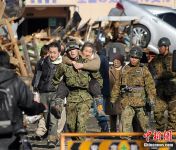Feel on the Street of Tokyo
 After arriving in what felt like a relatively calm city with a functioning public transport system last night, I awoke to news of rolling power outages across parts of the city, subway line cancellations, my first major tremor as a 6.2 aftershock swayed the building at a bit after 9am, predictions of more large tremors to come, plummeting stock markets and more worrying news from the troubled Fukushima Daiichi nuclear power plant.
After arriving in what felt like a relatively calm city with a functioning public transport system last night, I awoke to news of rolling power outages across parts of the city, subway line cancellations, my first major tremor as a 6.2 aftershock swayed the building at a bit after 9am, predictions of more large tremors to come, plummeting stock markets and more worrying news from the troubled Fukushima Daiichi nuclear power plant.
While searching for details about the reports of the electricity stoppages online in my hotel room, my Japanese mobile phone received an emergency SMS alert and within seconds I could feel the building sway. It was an unnerving sensation, but it did not last long and was not particularly violent.
But the suspicion that there could well be another one coming soon lingers in your mind - especially as the local press was quoting the Japanese Meteorological Agency as saying that it was 70% likely that Japan would experience a 7 or greater intensity quake over the coming three days.
After settling back in front of my computer and watching NHK report that the Nikkei index had fell 4% on opening, reports started coming through on CNN that an explosion had occurred at the No. 3 reactor of the Fukushima Daiichi nuclear power plant just after 11am.
The cumulative effect of transport congestion, fears of a nuclear meltdown, aftershocks, somewhat exaggerated reports of fuel and food shortages and the likelihood of power outages (though the ones schedules for the district my hotel is located in never came) would you think have put everyone on edge.
But venturing out into the city in the afternoon, Tokyo still appears to be functioning relatively calmly as people continue to go about their daily lives as best they can
Queues for the subway system seemed orderly and there were plenty of officials on hand to give instructions and advice.
The evening news reported large lines and long delays on the city’s subway system, footage of traffic jams (though they looked pretty tame by Beijing standards), reports of the power outages and news that now the fuel rods at the No. 2 reactor of the Fukushima Daiichi nuclear power plant were becoming exposed as water levels dropped emerged later in the evening.
Despite the stress and strains of the situation, maybe the fact that everyone in Tokyo knows they were lucky not to be near Semdai when the quake (and then Tsunami) struck and this helps to put their problems in perspective.
As the constant replays of devastating scenes on the various news channels remind them, the official death toll will surely climb much higher than the current 1,898 as the search and rescue effort on the country’s battered northeast coast continues.
The views posted here belong to the commentor, and are not representative of the Economic Observer |
Interactive
Multimedia

- EEO.COM.CN The Economic Observer Online
- Bldg 7A, Xinghua Dongli, Dongcheng District
- Beijing 100013
- Phone: +86 (10) 6420 9024
- Copyright The Economic Observer Online 2001-2011
















